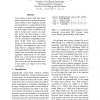Free Online Productivity Tools
i2Speak
i2Symbol
i2OCR
iTex2Img
iWeb2Print
iWeb2Shot
i2Type
iPdf2Split
iPdf2Merge
i2Bopomofo
i2Arabic
i2Style
i2Image
i2PDF
iLatex2Rtf
Sci2ools
ACL
2010
2010
Constituency to Dependency Translation with Forests
Tree-to-string systems (and their forestbased extensions) have gained steady popularity thanks to their simplicity and efficiency, but there is a major limitation: they are unable to guarantee the grammaticality of the output, which is explicitly modeled in string-to-tree systems via targetside syntax. We thus propose to combine the advantages of both, and present a novel constituency-to-dependency translation model, which uses constituency forests on the source side to direct the translation, and dependency trees on the target side (as a language model) to ensure grammaticality. Medium-scale experiments show an absolute and statistically significant improvement of +0.7 BLEU points over a state-of-the-art forest-based tree-to-string system even with fewer rules. This is also the first time that a treeto-tree model can surpass tree-to-string counterparts.
ACL 2010 | Computational Linguistics | Constituency-to-dependency Translation Model | State-of-the-art Forest-based Tree-to-string | Steady Popularity |
| Added | 10 Feb 2011 |
| Updated | 10 Feb 2011 |
| Type | Journal |
| Year | 2010 |
| Where | ACL |
| Authors | Haitao Mi, Qun Liu |
Comments (0)

